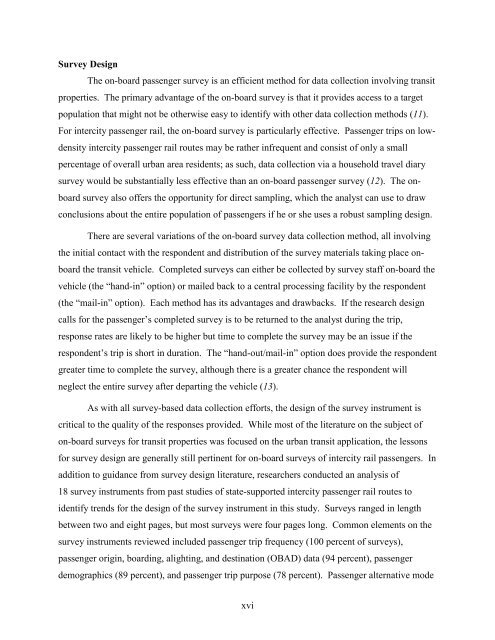Measuring the Benefits of Intercity Passenger Rail: A Study
Measuring the Benefits of Intercity Passenger Rail: A Study
Measuring the Benefits of Intercity Passenger Rail: A Study
You also want an ePaper? Increase the reach of your titles
YUMPU automatically turns print PDFs into web optimized ePapers that Google loves.
Survey Design<br />
The on-board passenger survey is an efficient method for data collection involving transit<br />
properties. The primary advantage <strong>of</strong> <strong>the</strong> on-board survey is that it provides access to a target<br />
population that might not be o<strong>the</strong>rwise easy to identify with o<strong>the</strong>r data collection methods (11).<br />
For intercity passenger rail, <strong>the</strong> on-board survey is particularly effective. <strong>Passenger</strong> trips on lowdensity<br />
intercity passenger rail routes may be ra<strong>the</strong>r infrequent and consist <strong>of</strong> only a small<br />
percentage <strong>of</strong> overall urban area residents; as such, data collection via a household travel diary<br />
survey would be substantially less effective than an on-board passenger survey (12). The onboard<br />
survey also <strong>of</strong>fers <strong>the</strong> opportunity for direct sampling, which <strong>the</strong> analyst can use to draw<br />
conclusions about <strong>the</strong> entire population <strong>of</strong> passengers if he or she uses a robust sampling design.<br />
There are several variations <strong>of</strong> <strong>the</strong> on-board survey data collection method, all involving<br />
<strong>the</strong> initial contact with <strong>the</strong> respondent and distribution <strong>of</strong> <strong>the</strong> survey materials taking place onboard<br />
<strong>the</strong> transit vehicle. Completed surveys can ei<strong>the</strong>r be collected by survey staff on-board <strong>the</strong><br />
vehicle (<strong>the</strong> “hand-in” option) or mailed back to a central processing facility by <strong>the</strong> respondent<br />
(<strong>the</strong> “mail-in” option). Each method has its advantages and drawbacks. If <strong>the</strong> research design<br />
calls for <strong>the</strong> passenger’s completed survey is to be returned to <strong>the</strong> analyst during <strong>the</strong> trip,<br />
response rates are likely to be higher but time to complete <strong>the</strong> survey may be an issue if <strong>the</strong><br />
respondent’s trip is short in duration. The “hand-out/mail-in” option does provide <strong>the</strong> respondent<br />
greater time to complete <strong>the</strong> survey, although <strong>the</strong>re is a greater chance <strong>the</strong> respondent will<br />
neglect <strong>the</strong> entire survey after departing <strong>the</strong> vehicle (13).<br />
As with all survey-based data collection efforts, <strong>the</strong> design <strong>of</strong> <strong>the</strong> survey instrument is<br />
critical to <strong>the</strong> quality <strong>of</strong> <strong>the</strong> responses provided. While most <strong>of</strong> <strong>the</strong> literature on <strong>the</strong> subject <strong>of</strong><br />
on-board surveys for transit properties was focused on <strong>the</strong> urban transit application, <strong>the</strong> lessons<br />
for survey design are generally still pertinent for on-board surveys <strong>of</strong> intercity rail passengers. In<br />
addition to guidance from survey design literature, researchers conducted an analysis <strong>of</strong><br />
18 survey instruments from past studies <strong>of</strong> state-supported intercity passenger rail routes to<br />
identify trends for <strong>the</strong> design <strong>of</strong> <strong>the</strong> survey instrument in this study. Surveys ranged in length<br />
between two and eight pages, but most surveys were four pages long. Common elements on <strong>the</strong><br />
survey instruments reviewed included passenger trip frequency (100 percent <strong>of</strong> surveys),<br />
passenger origin, boarding, alighting, and destination (OBAD) data (94 percent), passenger<br />
demographics (89 percent), and passenger trip purpose (78 percent). <strong>Passenger</strong> alternative mode<br />
xvi
















